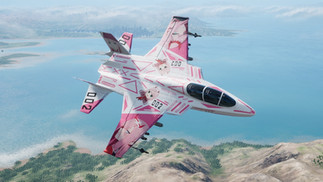
Original Post: 11/20/2021 | Major Update: 2/15/2025
Art on combat aircraft featuring beautiful women is an image that has been etched into aviation history. It is easy to conjure up a mental picture of Rita Hayworth, Betty Grable, or any other "bombshell" beauty on the side of an American World War II heavy bomber. In this day and age, people that partake in flight games and simulators have seen fewer examples of classic aircraft pinup nose art on social media and more of something like... 2D characters splashed across the wings of glittering fighter jets.
What seems to have started as a one-off crossover has become somewhat of a tradition in its own right. This phenomenon began in 2007 and has now spread far beyond the first series that introduced them on aircraft. It is about time someone provided a thorough explanation about where this trend of "wing waifus" came from and how it persists.
“Painful” Roots
Itasha (ee-tah-sha; イタ車) is a Japanese slang term used to describe this practice. Combining the words for “pain” and “vehicle,” it is used to describe highly decorated vehicles with the tone of the term being along the lines of “painfully embarrassing,” “painful for the wallet,” “painful to look at” or to use a modern Western term “cringeworthy.” This term is mainly used in jest by those who partake in the hobby directly.
The origins of this real-world practice vary, but generally it is accepted that its roots came from Japan in the 1980s. Back then, people would decorate their cars externally and internally with stickers, plushies, and similar memorabilia usually dedicated to one subject or individual. As Japanese anime became increasingly popular worldwide in the mid-2000s, some of the first reports of highly decorated cars appearing at conventions began in 2005. They spawned its own automotive-focused conventions, similar to car shows, in 2007. Nowadays, it’s an international practice; these vehicles can be found in just about any country.
It is well beyond just slapping a few stickers on the bumper. Even high-performance cars are purchased with custom wraps, body kits, and racing-grade hardware to take their presentation to the next level. The amount of money expended on a single itasha can easily reach tens or hundreds of thousands of US dollars when it is fully assembled. Depending on the complexity of the final product. This video from Zoom Out Media and DIY timelapse of a complete wrap by L-Dragon provide further examples. On the professional level, itasha cars are sponsored by companies to promote products, events, individuals and are used by racing teams.

The real world itasha cars have inspired many to create elaborate liveries for cars in games like Need for Speed, Forza, and similar titles. It is in this same vein that we begin to understand how this transferred to aircraft. Let’s use terms like ita-aircraft or ita-planes to describe them for our purposes.
Before we get to that, there’s something that should be addressed. In the beginning, the inclusion of the first itasha themed aircraft into a certain game was considered an easter egg by those that did not understand the concept.
Addressing this briefly, an easter egg is a sort of reference, clue, or inside joke placed into audio or visual media. A type of wink and nod to others that understand it that’s usually done subtlety. For example, the Ridge Racer and Tekken are well-known purveyors of references to other Bandai-Namco-owned video games. Its easter eggs are for many games from as early as the 1980s up to their recent titles. They are referenced in billboards, logos, racing teams, vehicle manufacturers, background scenery, and advertisements on buildings.
Itasha vs Pin Up
Directly equating pin up nose art to the itasha style is not correct. You could say that the pin up art style is more accepted globally as compared to the more recent itasha style. It is associated with aircrews in combat going as far back as World War II. Though, even during the rarely regulated nose art of that time period, the art remained in a relatively small area on the aircraft. Famously on the sides of the nose of aircraft. Modern examples echo the storied style of these pin ups, albeit with regulations on the messages they communicate, how explicit they can be and their size.
The itasha style is designed for no other purpose than openly conveying an overwhelming interest in something or someone. For a majority of people that see them, these aircraft are perhaps some of the gaudiest creatures to ever take to the skies. Covered from nose to tail with high visibility paint, interesting patterns, shimmering stars, stripes, hearts, and collages. It is hard to ignore them. Which is the point.
Below are three pictures of an F/A-18C Hornet in the itasha style and an F-5E-3 Tiger II with a traditional pin up style for comparison. Each livery designed to show support for the same subject. Note the juxtaposition.
The Idol Master
The inspirational source for the first ita-aircraft liveries. The Idol Master (stylized as "The iDOLM@STER", "IM@S") focuses on female and male artists on their journey to become successful idols in the music industry.

This Bandai-Namco-owned series started as an arcade-only game on the Namco 246 arcade system on July 26th, 2005. IM@S comprises dozens of games, animated TV series, live-action TV series, light novels, audio dramas, manga, live concerts, virtual reality experiences, and an ever-expanding discography of music. At its core, the overall story is centered around companies and producers of aspiring idols working to become successful in the music industry.
Much of the series’ initial success can be attributed to the enduring phenomenon of the Japanese idol. Since the idol boom in Japan in the 1970s, talent agencies have sought, trained, and promoted individuals and groups to have successful careers. The potential for high popularity idols is vast. Appearances in TV shows, acting in movies, becoming the face of social campaigns, stage plays, clothing lines, and many other commercial opportunities may await them. Needless to say, idols generate mobs of devoted fans that frequently put their images on itasha cars.
Ace Combat: Rise of the Ita-Aircraft

Ace Combat 6: Fires of Liberation (2007) was a significant release for that series. Downloadable content (DLC) was one of many new things introduced to the Ace Combat series with this game. DLC packs would include new aircraft liveries with adjusted specifications, single player missions and multiplayer missions.
November 22nd, 2007. This is where it begins. The release of DLC Pack 02 was the introduction of the first iDOLM@STER themed aircraft: Su-33 -THE IDOLMASTER MIKI-.

This itasha-styled livery would set the standard for all future designs. All DLC packs for Ace Combat 6 would include at least one new IM@S livery. The first iDOLM@STER game on the Xbox 360 that featured the original cast of characters was also released in 2007. The inclusion of its characters on aircraft in Ace Combat was a cross-promotional effort.
The impact of these brightly colored, decal-covered aircraft was immediate. Usually, the flashiest liveries found in flight games and simulators are based on real-world flight demonstration teams, CAG birds, military exercises like Tiger Meet, or aggressor squadrons from around the globe. There had never been an aircraft in an Ace Combat game or other flight titles up to this point that had the same design.

IM@S aircraft instantly garnered confusion, criticism, and a solid raft of support from the Ace Combat and Idol M@ster series fans. At the height of online activity, these aircraft were frequently seen in high-level multiplayer rooms. Opinions on their visuals aside, the benefits of their altered performance were undeniable to the point where specific IM@S aircraft became infamous. Hosts of multiplayer rooms and online competitive event planners would go as far as banning them and their users altogether.
With news of Ace Combat: Assault Horizon (2011) being set in the real world with a military fiction-style plot, IM@S aircraft seemed to be relegated to a one-time-only appearance. But not even the backdrop of a NATO anti-insurgency mission in Africa which turned into a military coup in Russia could halt the inclusion of IM@S aircraft as downloadable content. Additional monotone, more low-visibility style liveries were paired with updated versions of the Ace Combat 6 liveries.
The most extensive inclusion of iDOLM@STER themed aircraft came with Ace Combat Infinity (2014). By the end of the game’s service on March 31st, 2018, 13 aircraft, over 40 aircraft emblems, and a set of collaboration events encompassed the IM@S presence.

Of note is that Ace Combat: Assault Horizon, Ace Combat Infinity and Ace Combat Cross Rumble (2014) also had collaborations with Tekken, Ace Combat: Ikaros in the Sky and Amiibo toys for famous Namco characters like Luigi from the Super Mario series and Link from The Legend of Zelda series.
Curiously, Ace Combat 7: Skies Unknown (2019) still has not officially added ita-planes as of February 15th, 2025, though it does have emblems that can be applied to aircraft from one of the IM@S series.

Coming Full Circle
The animated idols of Japan may or may not make another official appearance in Ace Combat, but DLC pack from the Idolmaster: Starlit Season (2021) has shown an ADF-11 Raven fighter jet outfit available for its singing and dancing idols to wear on stage. Things truly came full circle.
Community Creation
The long-term presence of the ita-planes in a well-known series like Ace Combat resulted in the circulation of screenshots, videos, and fan art for many years now. Because of this influence, there are now ita-aircraft liveries for multiple games thanks to the efforts of skin modders (aka livery creators). Because they are now created by individuals outside of a game development team, they can be added to any sim the modders will commit their time and effort to.
Aircraft in these liveries are now available as free to download, or paid commissions for War Thunder, ARMA 3, Ace Combat, Digital Combat Simulator, Tom Clancy’s HAWX, Flight Simulator X, X-Plane, Strike Fighters 2, World of Warplanes, Nuclear Option, VTOL VR, Project Wingman, Microsoft Flight Simulator 2020/2024, VRChat, - the list goes on.
The subjects of these liveries are no longer solely characters from Bandai-Namco-owned intellectual property. Now just about any anime character, comic book character, musician, show, meme, content creator, VTuber, organization, event - nothing is unheard of. The image gallery below speaks for itself. Take note of the games these are from (hover mouse over image):
Indie Dev Inclusion
In a rare game developer example, ita-aircraft are the standard design in the game Fatal Employee Training (2012), developed by the Everyone in the Materials Department Doesn’t Learn their Lesson team, published by Project ICKX.
Within the vast world of VRChat aviation occasionally itasha aircraft appear depending on the preferences of the world creator. These examples not only show off their devotion to whatever their hobbies and interests are, but also present aircraft of their avatars or commemorate events.

This memorial aircraft is for a person that was a friend of the VRChat world creator behind Aircraft Carrier Jets: F-14. It has been present since 2020. Even in 2025 it continues to fly bearing the memory of this person as the world itself continues to be one of the more consistently popular aviation experiences on the platform.
Real World
There are real-world aircraft that follow the itasha style. The most well-known examples involve airliners operated by national airline companies designed to show off very successful anime series. Though there are also examples of privately owned aircraft adorned in this style by their owners. An especially interesting example is a Nier Automata themed Rutan VariEze based in Torrance Airport, California, USA. The Japanese Ground Self Defense Force is also known to have utilized ita-aircraft for recruitment purposes.
Creative Process (Guest Writer: Cubeboy)
While these paint schemes are not for everyone, there is something about creating them that I have always enjoyed. The first ones I ever made were for IL-2 1946, and more specifically, for a couple of the modern jet mods that were available for that game. They take a significant amount of effort and planning to create them. You have to adhere to a theme, usually one that fits the character you are basing the livery around. Then you have to select your color pallet, personally I like sticking to 4 colors and 2 secondary undertones. Then you have to think about the design itself taking into consideration the UV mapping of the 3D model. The more divided it is, the harder a livery like this becomes. For this example, let's use a full-body skin I made for Zweikaku, a virtual aviator and VRChat aviation world creator:

The theme for this livery was the Black Aces Squadron VVFA-41. I tried including their emblems and logos on places that would fit while also keeping an aesthetic balance between them and the main character art on the left wing. The colors I picked are the ones present in the character's clothing: maroon, dark gray, white and light pink. After the theme, design and art assets have been acquired; then I start start assembling the livery file. As you can see bellow, these kinds of liveries are not easy to assemble due to the way that the UV map has been laid out. As you can see in the image below, the 3D model for the DCS Hornet module has been divided into two main diffuses plus a couple of others for the external tanks, helmet, pilot textures, etc. Diffuse 1 includes the nose and tail sections of the fuselage, plus part of the hump and almost all the mechanical parts. Diffuse 2 includes the wings, elevons, vertical stabilizers and the mid section of the fuselage plus the back part of the hump, pylons, external model cockpit textures, etc.

The hardest part, by far, is when it comes to the alignment of the character art in the wing. As you can see the wing is divided into several sections, one per movable section. It is really easy to see that these parts are not perfectly aligned, which requires a lot of tweaking and sometimes even re-drawing of the art in question.
In this case, I had to play with the proportions of the character, her pose and even a bit of re-drawing on her left arm. I also included, for the first time, a complete character art. That means that the legs and feet have to be proportioned in such a way that you can imagine the entire body even when half of it is missing. That meant that I had to play with the pose of her legs in order to have them fit inside the left elevon.
But after all that hard work (which included a new set of roughmet textures, engine feathers and some normalmap tweaks), you end up with something that does not look that bad, if you are into this kind of thing!

Established Tradition
Like it or not, the presence of itasha style aircraft in flight games and simulators has been established and perpetuated since 2007. Whether they’re original fans of the Idol Master aircraft or creators expressing devotion to their interests, people continue bringing these designs to every place they take to the skies.
About the Writer
Aaron "Ribbon-Blue" Mendoza

Co-founder of Skyward Flight Media. After founding Electrosphere.info, the first English Ace Combat database, he has been involved in creating flight game-related websites, communities, and events since 2005. He explores past and present flight games and simulators with his extensive collection of game consoles and computers. Read Staff Profile.








































































.png)